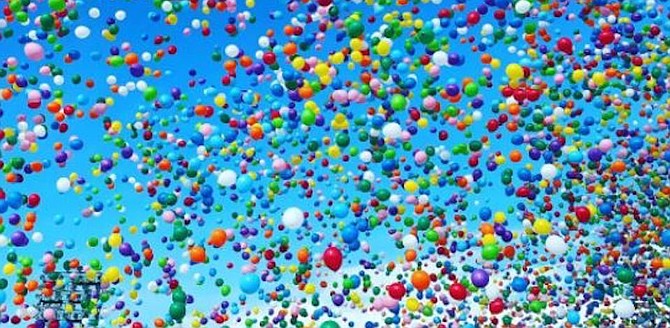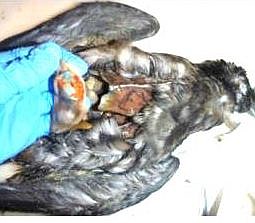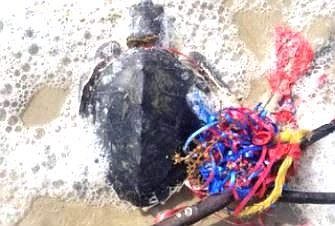 Facebook
Facebook
 X
X
 Instagram
Instagram
 TikTok
TikTok
 Youtube
Youtube

Next month, the city of Encinitas will consider a ban on helium-filled balloons, a proposal that has garnered more support letters than any topic ever heard by the environmental commission.
Some balloon businesses, however, are worried.

Helium balloons wreak havoc by floating up, up and away before goring themselves on trees, poles and powerlines. They pick up chemicals, break into tiny toxic bits, get swallowed by, or ensnare wildlife, and spark fires.
"Balloons are a wasteful, single-use product that quickly become trash," the city says. As they turn into beach litter, city costs go up.
The ordinance, part of the city's work plan to reduce plastic pollution, excludes scientific balloons used by the state or federal governments, and hot air balloons.
What will it mean for local balloon businesses?

"A ban on helium will hurt the party stores more than the professional balloon companies," says Sandi Masori, with Balloon Utopia in San Diego.
"Most of us do the majority of our designs using framing and air-filled balloons. They last longer, can be made into amazing art or displays, and since they don’t need helium, "it just means we need to be a little more creative."
Framing could be as simple as a baseplate and pole for a column to a 3-D topiary sculpture made with plants, she says. "Because you’re attaching the balloons to a frame, you can use regular air to fill them. This means the balloons won’t float, nor do they need to."
Party stores, on the other hand, sell helium-filled balloons only, she says. "They often use it as a loss leader to get people into the store, so don’t have as much room to pivot to the more time-consuming air-filled decor."

The city found that helium balloons, made of latex or Mylar, are sold in approximately eight retail stores in Encinitas (Smart n’ Final, Stater Brothers, Vons, 99 Cents Only, Ralphs, 1-800-Flowers, Party City and The Dollar Store).
Three of the outlets answered an informal survey from the city, while five declined. Party City sells the most lighter-than-air balloons, 20 percent of their overall sales, followed by 1-800 Flowers where the balloons are 15 percent of sales. The Dollar Store sells the fewest – one percent.
Many of the retailers sell balloon arrangements that don't require helium. A recent helium shortage has led to greater use of air-filled balloon designs, the city says. Increased sales of these are expected to "off-set the loss of revenue from lighter than air balloon sales and also provide the public with viable alternatives."
Robert Costantino, with Sorrento Valley based Balloon Guru, sees it differently. "A ban on helium-filled latex balloons would result in an estimated 30-40 percent loss in business sales and would be devastating to our industry and to our local economy."
Balloon Guru sells biodegradable and organic balloon options, as well as metallic, gold, confetti, and helium balloons.
The balloon industry is largely composed of small, family-run businesses that depend on sales of helium-filled latex balloons, he says. His business employs nine people "and we are looking for more help as we speak."
He calls it a "prevalent misconception" that latex balloons are a form of single-use plastic. "The latex balloons we use are all 100 percent natural latex (rubber) and are biodegradable."
The idea is echoed by Masori, who says most people "don’t understand that latex balloons are totally biodegradable and are made from the sap of the rubber tree."
Surfrider Foundation, which first prompted Encinitas to consider a ban, and hopes to expand it to other local cities, says thousands of helium filled balloons are released into the sky every day.
They go on to kill thousands of marine wildlife like sea turtles who mistake the bright orbs for food, only to have the plastic block their digestive tracts and slowly starve them to death. Latex balloons are the type most commonly found in the stomachs of dead animals, the foundation says.
Natural latex may be biodegradable, but after adding chemicals and plasticizers, it's not entirely so, they say. It may degrade after many years, but it’s neither natural nor truly "biodegradable."
Florida, for instance, doesn't recognize any balloon as biodegradable.
California doesn't have a law related to latex balloons but does prohibit the release of Mylar balloons and requires retailers to weight them down.
Yet balloon keeps meeting power line.
San Diego Gas & Electric reports that Mylar balloons - which are made of nylon and never degrade - have caused over 500 outages in the last five years.The metallic coating that gives them their bright color conducts electricity, causing an outage if they tangle with a power line.
Costantino says he favors "educating the public about the proper use of balloons" over a ban. "We have long since stopped offering balloons when they are intended for release."


Next month, the city of Encinitas will consider a ban on helium-filled balloons, a proposal that has garnered more support letters than any topic ever heard by the environmental commission.
Some balloon businesses, however, are worried.

Helium balloons wreak havoc by floating up, up and away before goring themselves on trees, poles and powerlines. They pick up chemicals, break into tiny toxic bits, get swallowed by, or ensnare wildlife, and spark fires.
"Balloons are a wasteful, single-use product that quickly become trash," the city says. As they turn into beach litter, city costs go up.
The ordinance, part of the city's work plan to reduce plastic pollution, excludes scientific balloons used by the state or federal governments, and hot air balloons.
What will it mean for local balloon businesses?

"A ban on helium will hurt the party stores more than the professional balloon companies," says Sandi Masori, with Balloon Utopia in San Diego.
"Most of us do the majority of our designs using framing and air-filled balloons. They last longer, can be made into amazing art or displays, and since they don’t need helium, "it just means we need to be a little more creative."
Framing could be as simple as a baseplate and pole for a column to a 3-D topiary sculpture made with plants, she says. "Because you’re attaching the balloons to a frame, you can use regular air to fill them. This means the balloons won’t float, nor do they need to."
Party stores, on the other hand, sell helium-filled balloons only, she says. "They often use it as a loss leader to get people into the store, so don’t have as much room to pivot to the more time-consuming air-filled decor."

The city found that helium balloons, made of latex or Mylar, are sold in approximately eight retail stores in Encinitas (Smart n’ Final, Stater Brothers, Vons, 99 Cents Only, Ralphs, 1-800-Flowers, Party City and The Dollar Store).
Three of the outlets answered an informal survey from the city, while five declined. Party City sells the most lighter-than-air balloons, 20 percent of their overall sales, followed by 1-800 Flowers where the balloons are 15 percent of sales. The Dollar Store sells the fewest – one percent.
Many of the retailers sell balloon arrangements that don't require helium. A recent helium shortage has led to greater use of air-filled balloon designs, the city says. Increased sales of these are expected to "off-set the loss of revenue from lighter than air balloon sales and also provide the public with viable alternatives."
Robert Costantino, with Sorrento Valley based Balloon Guru, sees it differently. "A ban on helium-filled latex balloons would result in an estimated 30-40 percent loss in business sales and would be devastating to our industry and to our local economy."
Balloon Guru sells biodegradable and organic balloon options, as well as metallic, gold, confetti, and helium balloons.
The balloon industry is largely composed of small, family-run businesses that depend on sales of helium-filled latex balloons, he says. His business employs nine people "and we are looking for more help as we speak."
He calls it a "prevalent misconception" that latex balloons are a form of single-use plastic. "The latex balloons we use are all 100 percent natural latex (rubber) and are biodegradable."
The idea is echoed by Masori, who says most people "don’t understand that latex balloons are totally biodegradable and are made from the sap of the rubber tree."
Surfrider Foundation, which first prompted Encinitas to consider a ban, and hopes to expand it to other local cities, says thousands of helium filled balloons are released into the sky every day.
They go on to kill thousands of marine wildlife like sea turtles who mistake the bright orbs for food, only to have the plastic block their digestive tracts and slowly starve them to death. Latex balloons are the type most commonly found in the stomachs of dead animals, the foundation says.
Natural latex may be biodegradable, but after adding chemicals and plasticizers, it's not entirely so, they say. It may degrade after many years, but it’s neither natural nor truly "biodegradable."
Florida, for instance, doesn't recognize any balloon as biodegradable.
California doesn't have a law related to latex balloons but does prohibit the release of Mylar balloons and requires retailers to weight them down.
Yet balloon keeps meeting power line.
San Diego Gas & Electric reports that Mylar balloons - which are made of nylon and never degrade - have caused over 500 outages in the last five years.The metallic coating that gives them their bright color conducts electricity, causing an outage if they tangle with a power line.
Costantino says he favors "educating the public about the proper use of balloons" over a ban. "We have long since stopped offering balloons when they are intended for release."
Comments